The Apple iPhone 6s and iPhone 6s Plus Review
by Ryan Smith & Joshua Ho on November 2, 2015 8:00 AM EST- Posted in
- Smartphones
- Apple
- Mobile
- SoCs
- iPhone 6s
- iPhone 6s Plus
Display
In pretty much any smartphone, displays are going to be one of the most important aspects of the user experience. If a display is dim or has a highly reflective display it will be unreadable outdoors. If the contrast is low, the display can become difficult to read and not particularly appealing to the eye. Other issues like lack of color stability and contrast stability with changes in viewing angles will be much more noticeable than on something like a laptop or desktop where the monitor is usually kept at a constant position in space relative to the eye. In order to evaluate these factors we use both relative comparisons and absolute measurements. Although the human eye is sufficient for relative comparison, for absolute measurements we use X-Rite’s i1Pro2 spectrophotometer for precise color and luminance measurements, along with X-Rite’s i1Display Pro colorimeter for accurate contrast figures. Hardware alone is insufficient for collecting and presenting data, so we also use SpectraCal’s CalMAN 5 with a custom workflow, which allows for collecting and presenting data in a readable manner.
In the case of the iPhone 6s and iPhone 6s Plus, the display appears to be effectively unchanged from the iPhone 6 and iPhone 6 Plus. The iPhone 6s retains the 1334x750 resolution of the previous variant, and the iPhone 6s Plus has the same 1080p resolution as well. Apple continues to use the same M2 scaler as well, which means that although the display’s physical resolution is 1080p Apple is actually rendering the display at 2208x1242 and scaling it to fit the display. The resolution of the iPhone 6s is on the low side relative to most Android devices, which is noticeable but the pixel density is sufficient to avoid any obvious problems here.
As with the iPhone 6, both the iPhone 6s and 6s Plus use dual domain pixels, which make the subpixels look more like chevrons under a microscope. This improves viewing angles by reducing the amount of color shifting that occurs when the display viewing angle is changed. As far as I can tell, Apple continues to be one of the few OEMs that pulls this off effectively. Although contrast and luminance aren’t perfectly consistent with changes in viewing angles, it basically looks like the display is painted underneath the glass. The iPhone 6s Plus does a better job at pulling off this illusion as the higher pixel density helps to eliminate some of the fuzziness or pixilation that might otherwise occur. Samsung gets close here, but for whatever reason ambient light causes noticeable interference effects and in general there’s noticeable color shift when moving the display around. Weirdly enough, the OEM that seems to be doing the best job here continues to be HTC with the One M9+.

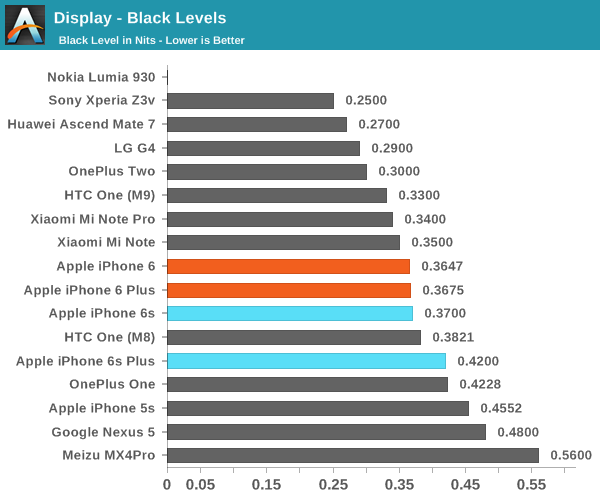
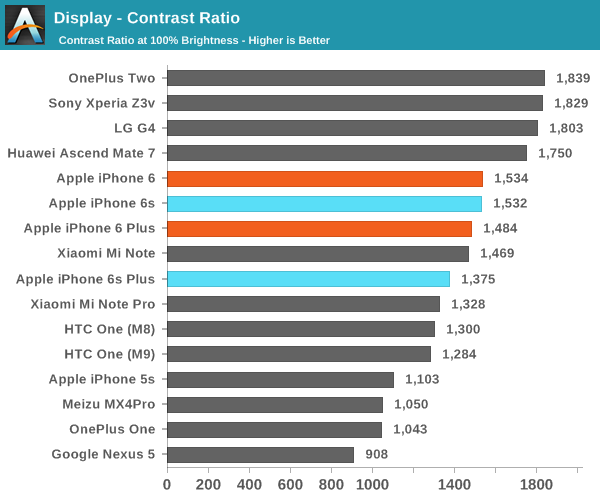
Moving on to our usual brightness and contrast testing, it looks like Apple has improved the maximum brightness of their displays with the use of the new LED backlight driver, but it’s important to note that in the case of the iPhone 6s, the maximum brightness isn’t constant. The behavior is relatively subtle, but with iOS 9 at maximum brightness the display brightness steadily lowers over the course of an hour by about 10 nits maximum. It looks like this effect tails off in both the rate of luminance decrease and overall luminance decrease as peak brightness approaches 500 nits, where the effect appears to be non-existent. It’s likely that this behavior is designed to reduce the battery impact of keeping the display at maximum brightness in all situations. Either way, peak luminance is high enough that it isn’t a struggle to read the display outdoors and contrast in low-light conditions also remains high due to the use of photo-alignment in the liquid crystal layer which helps to make the liquid crystals stay in the right shape.
iPhone 6s
iPhone 6s Plus

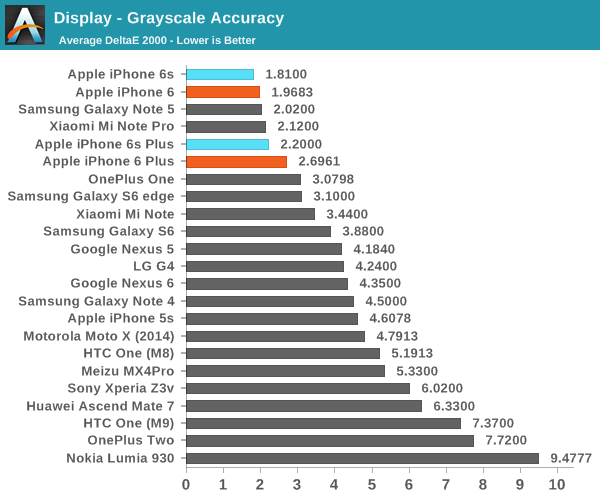
In grayscale, we don’t quite see the near-perfect white balance we saw last year but gamma remains almost impeccable when compared to the industry standard power 2.2 gamma. I suspect that the units we received this time are closer to the mean for white balance compared to last year, as in general due to the blue LED backlights used in most LCDs a colder color balance will generally require less power to display than a warmer one.
iPhone 6s
iPhone 6s Plus

In our saturation sweep testing, the iPhone 6s and 6s Plus both continue to track closely to expected values for sRGB, which is the current industry standard color gamut. I don’t really have any criticism here. The previous iPhone’s displays were of similar caliber, so this is pretty much par for the course if you’re used to iPhone displays.
iPhone 6s
iPhone 6s Plus
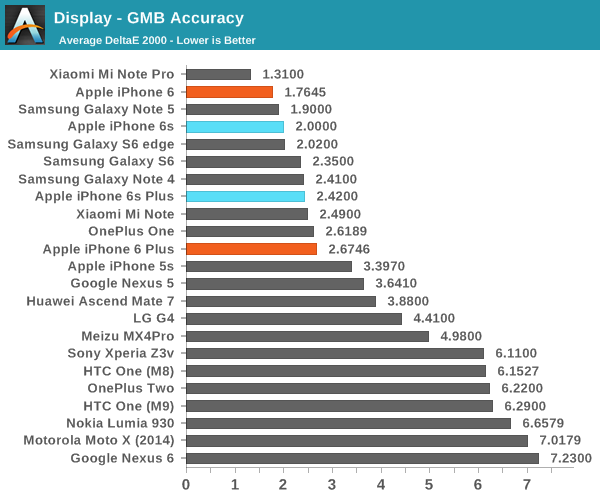
Similarly in the GMB ColorChecker, the iPhone 6s and 6s Plus both pass with flying colors. If you’re using an iPhone 6s or 6s Plus for any remotely color-critical work like viewing and/or editing photos and videos, it’s a pretty fair bet that you’ll be able to rely on these phones to provide an accurate color reproduction in pretty much any condition. Samsung does provide better contrast and the possibility of extra color saturation with their Galaxy S6 and Note 5, but this comes at the cost of potential for burn-in, increased power consumption in certain scenarios, and increased distortion with changes in viewing angles. I think this means that it basically comes out to a wash, but depending upon personal taste one may prove to be better than another.



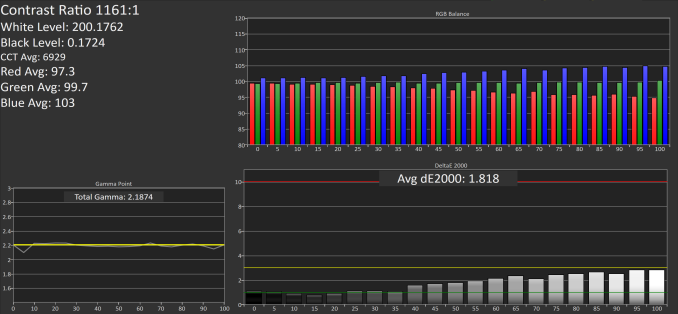
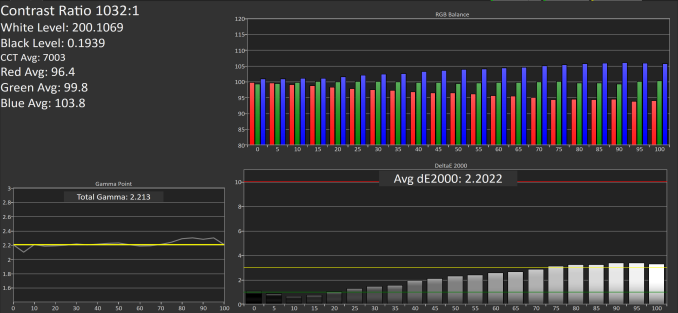
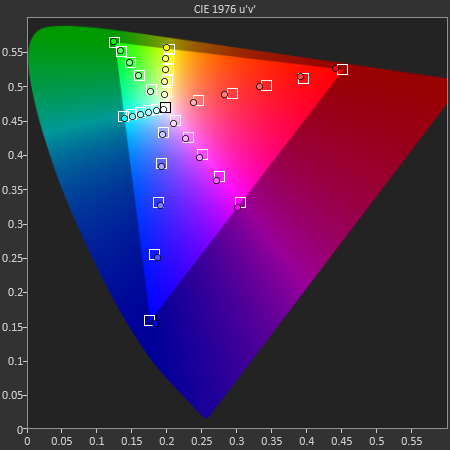
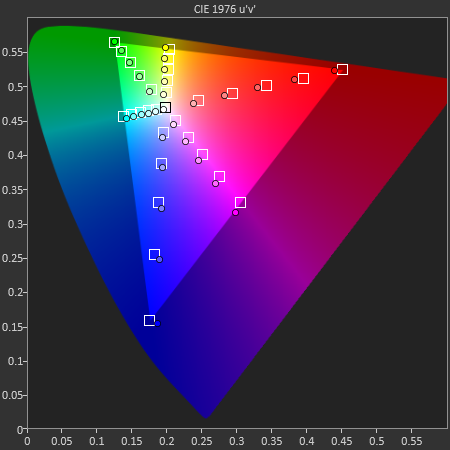
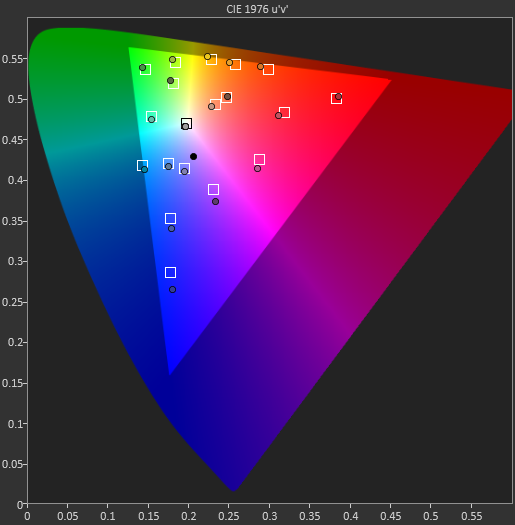
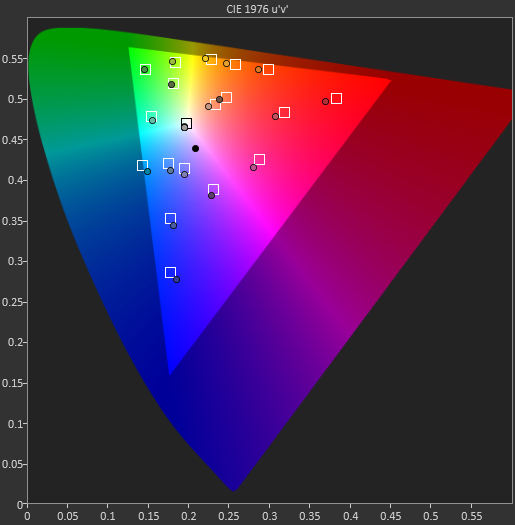








531 Comments
View All Comments
IanHagen - Wednesday, November 4, 2015 - link
Would you be so kind and post some sort of source for the allegedly professional review that deemed the iPhone camera as really poor? I'll be waiting by the sea.hlovatt - Monday, November 2, 2015 - link
Fantastic review, particularly liked the deep dive on the CPU.It must be hard to ignore the nasty comments some people make because you don't like their favourite phone as much as some other brand. Rest assured that their are many more people who appreciate your efforts than those who seem to have way too much invested in their choice of phone.
FunBunny2 - Monday, November 2, 2015 - link
-- * Especially the SoCSo, yes or no (and show your work): the Apple Ax processors are modified ARM ref. devices simply by adding off-the-shelf functionality available to any engineer with an HDL/CAD/etc. workstation? Seems so from all the various descriptions, here and elsewhere.
extide - Monday, November 2, 2015 - link
No they are clean sheet implementations of the ARM v8 instruction set. No off the shelf ARM Cortex CPU is even remotely similar, they are all much narrower designs. This chip is honestly designed more like an Intel Core CPU than an ARM one. Too bad you can only get it in an iPhone :(Byte - Monday, November 2, 2015 - link
Im a hardcore MS hore and hate Apple. But their iPhones cannot be beat. Android STILL feels like Windows Mobile phone which I i've used years before smartphone was a thing, starting with Palms. I'm a bit disappointed with the new camera, but pictures still look better on an iPhone than S6 even with Samsungs far superior screens. Android only had a short uptick when iPhones were stuck in the low screen sizes, but now Apples stronghold is insane. It will only take a paradigm shift from actual phones to challenge that, which might be very soon.pliablemoosethebanned - Monday, November 2, 2015 - link
Ignore the idiots, great review guys.Caliko - Tuesday, November 3, 2015 - link
With Apple's track record,You have a better chance building a snowman in hell than get them to pay you for something.
Alexey291 - Tuesday, November 3, 2015 - link
So you're implying that they forfeit their marketing contracts? I'm just asking because you seem to be the resident apple expert hereBragabondio - Tuesday, November 3, 2015 - link
I guess, to avoid comments like the above you guys need to state in the summary if you are using Iphone, Android or s/g else as a daily driver.The idea is that all of us have our preferences and biases but sometimes when we like an ecosystem (or if we were more familiar with a particular ecosystem) we made decision on what is important to review based on personal preferences and biases. For example, I like a lot a CNET review of the new Apple TV where the author immediately stated he is an Android guy. So when at the end he gave it an overall score of 4 out of 5, people who are into Apple ecosystem are aware that the product was reviewed by somebody who may have different expectations about what a streamer/casual game machine should do compared to them.
I guess most of you guys from Anandtech are into Apple so it is difficult to find somebody who can provide an alternative angle but at least you can state where you are coming from.
The SoC of the new Iphones may be great but if I can paraphrase the Russian proverb it is not the SoC alone that makes the phone great.
jospoortvliet - Wednesday, November 4, 2015 - link
Well didn't the author write his daily phone is a HTC One M7? And compare the iPhone with it at some points? I have the One as well and he said the right things - looks like Apple has simply done a great job on almost every front.